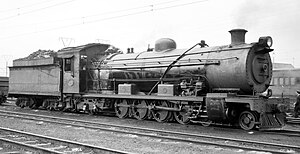Template:Infobox steam wheel arrangement/doc
Jump to navigation
Jump to search
| This is a documentation subpage for Template:Infobox steam wheel arrangement. It contains usage information, categories and other content that is not part of the original template page. |
This is an infobox for steam locomotive wheel arrangements using the Whyte notation. For locomotives, use {{Infobox locomotive}} and for steam locomotive tenders, use {{Infobox steam tender}} instead.
Contents
Usage
 Front of locomotive at left | |||||||||||||||||||
 NGR Hendrie D, the first true Mountain locomotive | |||||||||||||||||||
| |||||||||||||||||||
| |||||||||||||||||||
| |||||||||||||||||||
| |||||||||||||||||||
Parameters
This template has a number of parameters, all of which are optional:
- name – The article title, e.g. 4-4-0 (The most commonly used name of the wheel arrangement, in brackets)
- image - Wheel arrangement schematic
- alt - Alternative text for the image, displayed when the image cannot be shown (such as for visually impaired users, or for spoken articles)
- caption - Front of locomotive at left (only if non-symmetrical)
- image2 - Loco picture, if possible preferably the first one to use this wheel arrangement
- alt2 - Alternative text for the image
- caption2 - Loco picture description
Equivalent classifications
- hatnote - A label-less centered text field for notices
- UIC/Germany/Italy – Alternative UIC, German or Italian classification
- French/Spanish - Alternative French or Spanish classification
- Turkish - Alternative Turkish classification
- Swiss - Alternative Swiss classification
- Russian - Alternative Russian classification
First tank engine version
- date - Year introduced
- country – Country first used in
- locomotive – First locomotive with this wheel arrangement
- railway – First railway to use this wheel arrangement
- designer – Designer who introduced this wheel arrangement
- builder – Builder of the first locomotive with this wheel arrangement
- evolvedfrom - The wheel arrangement(s) from which it evolved
- evolvedto - The wheel arrangement(s) which evolved from it
- mainbenefit – For example wider firebox, reduced axle load, stability etc
- maindrawback – For example narrow firebox, instability at speed, etc
First tender engine version
- date2 - Year introduced
- country2 – Country first used in
- locomotive2 – First locomotive with this wheel arrangement
- railway2 – First railway to use this wheel arrangement
- designer2 – Designer who introduced this wheel arrangement
- builder2 – Builder of the first locomotive with this wheel arrangement
- evolvedfrom2 - The wheel arrangement(s) from which it evolved
- evolvedto2 - The wheel arrangement(s) which evolved from it
- mainbenefit2 – For example wider firebox, reduced axle load, stability etc
- maindrawback2 – For example narrow firebox, instability at speed, etc
First "True type" version (Use for locomotives where the full potential deriving from the wheel arrangement was first used. See 4-8-2 for an example)
- date3 - Year introduced
- country3 – Country first used in
- locomotive3 – First locomotive with this wheel arrangement
- railway3 – First railway to use this wheel arrangement
- designer3 – Designer who introduced this wheel arrangement
- builder3 – Builder of the first locomotive with this wheel arrangement
- evolvedfrom3 - The wheel arrangement(s) from which it evolved
- evolvedto3 - The wheel arrangement(s) which evolved from it
- mainbenefit3 – For example wider firebox, reduced axle load, stability etc
- maindrawback3 – For example narrow firebox, instability at speed, etc
Separate multiple values by using {{Plainlist}} or {{Flatlist}}.
Example
{{Infobox steam wheel arrangement
| name = 4-4-0 (American)
| image = Wheel arrangement schematic
| alt =
| caption = Front of locomotive at left (only if non-symmetrical)
| image2 = Loco picture, preferably the first one to use this arrangement
| alt2 =
| caption2 = Loco description
<!--Equivalent classifications-->
| hatnote =
| UIC/Germany/Italy=
| French/Spanish =
| Turkish =
| Swiss =
| Russian =
<!--First tank engine version-->
| date = Year introduced
| country = First user
| locomotive = First loco
| railway = First railway
| designer =
| builder =
| evolvedfrom = wheel arrangement(s)
| evolvedto = wheel arrangement(s)
| mainbenefit = wider firebox, reduced axle load, stability etc
| maindrawback = narrow firebox, instability at speed, etc
<!--First tender engine version-->
| date2 = Year introduced
| country2 = First user
| locomotive2 = First loco
| railway2 = First railway
| designer2 =
| builder2 =
| evolvedfrom2 = wheel arrangement(s)
| evolvedto2 = wheel arrangement(s)
| mainbenefit2 = wider firebox, reduced axle load, stability etc
| maindrawback2 = narrow firebox, instability at speed, etc
<!--First "True type" version-->
| date3 = Year introduced
| country3 = First user
| locomotive3 = First loco
| railway3 = First railway
| designer3 =
| builder3 =
| evolvedfrom3 = wheel arrangement(s)
| evolvedto3 = wheel arrangement(s)
| mainbenefit3 = wider firebox, reduced axle load, stability etc
| maindrawback3 = narrow firebox, instability at speed, etc
}}
See also
{{Infobox locomotive}}– for steam, electric and diesel locomotives{{Infobox steam tender}}- for steam locomotive tenders{{Infobox train}}– for trams/streetcars, multiple units and passenger cars{{Infobox German railway vehicle}}– for direct translations of articles copied from the German Wikipedia, pending conversion to{{Infobox train}}or{{Infobox locomotive}}format